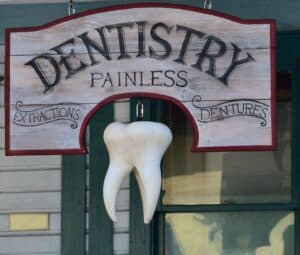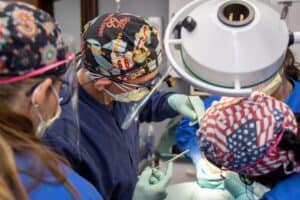The History of Wisdom Tooth Removal
An Oral Surgery History…
Wisdom tooth removal is a necessity, but it has come a long way in recent years, largely due to advents in anesthesia. The use of local anesthetics is actually a relatively recent development. In fact, the first local anesthetic used by dentists was Novacaine, which was developed in 1905.

Until then, teeth weren’t removed until they became infected and painful — so painful that people would rather have them pulled without any anesthetic than continue enduring the pain!
Anesthesiology started out as a dental specialty in the 1800s with the use of nitrous oxide (also known as laughing gas). Originally, dentists used what was known as the black gas technique, which called for the administration of 100 percent nitrous oxide and no oxygen.
Technically speaking, patients weren’t really anesthetized. They simply passed out from lack of oxygen. Dentists would then work as quickly as possible before administering oxygen to the patient so they regained consciousness.
After a few years of seeing what dentists were able to do, medical doctors followed suit, and that’s basically how the use of anesthesia began.
The development of oral surgery as a specialty came about as an outgrowth of both medicine and dentistry.
Dental schools were first established about 150 years ago, but the real “science” of oral surgery didn’t begin until approximately 50 years later.
A few, large teaching hospitals introduced programs that involved dentists in the treatment of facial fractures. And from the cooperation between dentists and surgeons, the specialty of oral surgery was born. In 1918, oral surgery became the first area of specialization in dentistry.
An oral surgeon undergoes significantly more training than a general dentist. A general dentist completes a four-year program that typically includes about two years of anatomy and pathology, basic medical science, and basic principles of dental science.
This is followed by two years of clinical training that involves hands-on practice with fillings, caps, root canals, cleanings, and gum treatments.
What about wisdom tooth removal?
With all of the instruction mentioned above, students receive very little training with regards to extractions, particularly wisdom tooth extractions. Dental school also teaches the basics of anesthesia, which by and large involves local shots of Novacaine. Some schools will train students in the use of nitrous oxide gas, while others won’t.

In my basic training at Northwestern University Dental School, there were lectures on the use of nitrous oxide, but I never actually used it in a clinical setting. When I pursued specialization in oral surgery, however, I received comprehensive training in the use of anesthesia.
In order to become an oral surgeon, a student must first complete the four years of academic and clinical training that every general dentist receives, and then continue on to an additional program that takes four to seven years to complete.
During those additional four to seven years, dentists receive clinical experience in all aspects of oral surgery, including anesthesia. In fact, oral surgery residents spend six months with the anesthesia department at the hospital where they receive the rest of their training.
In a future blog, I’ll discuss the three types of anesthesia used for wisdom tooth removal. In the meantime, if you’d like to learn more about the WisdomToothDoc™ Technique, please contact us.